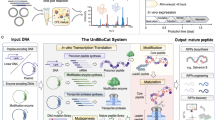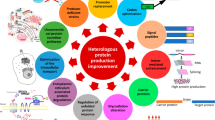Summary
-
1.
Cap-formation of nucleated and enucleated plants of Acetabularia mediterranea was inhibited by 10–50 μg/ml p-fluorophenylalanine almost completely, while the formation of the stalk and whorls as well as protein synthesis is only slightly affected.
-
2.
This selective inhibition of cap-formation by fluorophenylalanine is cancelled by phenylalanine or tyrosine.
-
3.
The inhibition caused by flourophenylalanine is reversible if the plants are transferred into Erdschreiber medium without fluorophenylalanine before cap-formation starts. But the inhibition is largly (nucleated plants) or totally (enucleated plants) irreversible, if the back-transfer takes place after a large part of the control plants has finished cap-formation.
-
4.
Plants which were exposed to fluorophenylalanine a few days before cap-formation is initiated are able to form a small cap, but further growth of the cap is stopped.
-
5.
The following conclusions can be drawn from these results. The activities of the proteins which control stalk-and whorl formation in Acetabularia mediterranea are not influenced by the incorporation of p-fluorophenylalanine. On the other hand one or a few proteins which control cap-formation are inactivated by the incorporation of the fluorine-containing analogue. Therefore cap-formation is controlled by another set of enzymes and structural proteins than stalk-und whorl formation.
-
6.
The synthesis of the proteins which are specific for cap-formation is started a few days before the actuel onset of cap-formation. Synthesis of these specific proteins is also necessary for the further growth of the cap.
Zusammenfassung
-
1.
p-Fluorphenylalanin blockiert bei kernhaltigen und kernlosen Pflanzen von A. mediterranea in den Konzentrationen von 10–50 μg/ml fast vollständig die Hutbildung, während Stiel-und Wirtelbildung sowie die Proteinsynthese nur wenig beeinflußt werden.
-
2.
Diese selektive Hemmung der Hutbildung wird aufgehoben, wenn dem Kulturmedium zusammen mit dem Fluorphenylalanin Phenylalanin oder Tyrosin zugesetzt werden.
-
3.
Die Fluorphenylalanin-Hemmung ist reversibel, wenn die Pflanzen vor dem Beginn der Hutbildung aus dem Fluorphenylalanin-Medium in normale Erdschreiber-Lösung zurückversetzt werden. Erfolgt die Rückübertragung erst dann, wenn ein großer Teil der Kontrollpflanzen bereits Hüte gebildet hat, so ist die Hemmung ganz (kernoloser Pflanzen) oder teilweise (kernhaltige Pflanzen) irreversibel.
-
4.
Pflanzen, die erst kurz vor Beginn der Hutbildung Fluorphenylalanin ausgesetzt werden, sind z. T. in der Lage, einen kleinen Hut zu bilden. Das weitere Hutwachstum wird durch Fluorphenylalanin unterdrückt.
-
5.
Aus diesen Befunden wird der Schluß gezogen, daß die Stiel- und Wirtelbildung bei A. mediterranea von Proteinen bestimmt wird, auf die der Einbau von Fluorphenylalanin keinen Einfluß hat, während ein oder mehrere der für die Hutbildung verantwortlichen Proteine durch den Einbau inaktiviert werden. Für die Hutbildung ist also eine andere Garnitur von Enzym- und Strukturproteinen erforderlich als für die Stiel- und Wirtelbildung.
-
6.
Die Synthese der für die Hutbildung spezifischen Proteine setzt erst wenige Tage vor dem Beginn der sichtbaren Hutbildung ein und ist auch für das weitere Hutwachstum erforderlich.
Similar content being viewed by others
Literatur
Backer, R. S., J. E. Johnson, and S. W. Fox: Incorporation of p-fluorophenylalanine into proteins of Lactobacillus arabinosus. Biochim. biophys. Acta (Amst.) 28, 318–327 (1958).
Blum, J. J.: Observations of the acid phosphatase of Euglena gracilis. J. Cell Biol. 24, 223–234 (1965).
Brachet, J.: The role of nucleic acids in morphogenesis. Progr. Biophys. and molec. Biol. 15, 99–127 (1965).
Clauss, H.: Über die Intensität der Proteinsynthese von Acetabularia vor und nach der Hutbildung. Z. Naturforsch. 17b, 342–344 (1962).
Cohen, G. N., and R. Munier: Effects des analogues structuraux d'amino acids sur la croissance la synthese de proteines et la synthese d'enzymes chez Escherichia coli. Biochim. biophys. Acta (Amst.) 31, 347–356 (1959).
Cowie, D. B., G. N. Cohen, E. T. Bolton, and H. Robichon-Szulmajster: Amino acid analog intercorporation into bacterial proteins. Biochim. biophys. Acta (Amst.) 34, 39–46 (1959).
Hämmerling, J.: Nucleo-cytoplasmic interactions in Acetabularia and other cells. Ann. Rev. Plant Physiol. 14, 65–92 (1963).
—, u. Ch. Hämmerling: Kernaktivität bei aufgehobener Photosynthese. Planta (Berl.) 52, 516–527 (1959).
Munier, R., and G. N. Cohen: Incorporation d'analogues structuraux d'amino acides dans les proteines bacteriennes au cours de leur synthese in vivo. Biochim. biophys. Acta (Amst.) 31, 378–391 (1959).
Richmond, M. H.: Random replacement of phenylalanine by p-Fluorphenylalanine in alkaline phosphatase(s) formed during biosynthesis by E. coli. J. molec. Biol. 6, 284–294 (1963).
— The enzymic basis of specific antibacterial action of structural analogues. Biol. Rev. 40, 93–128 (1965).
Zetsche, K.: Hemmung der Synthese morphogenetischer Substanzen im Zellkern von Acetabularia mediterranea durch Actinomycin D. Z. Naturforsch. 19b, 751–759 (1964).
— Anreicherung von morphogenetischen Substanzen in Lichtpflanzen von Acetabularia mediterranea unter dem Einfluß von Puromycin. Planta (Berl.) 64, 119–128 (1965).
Author information
Authors and Affiliations
Rights and permissions
About this article
Cite this article
Zetsche, K. Entkopplung morphogenetischer Prozesse in Acetabularia mediterranea durch P-Fluorphenylalanin. Planta 68, 360–370 (1966). https://doi.org/10.1007/BF00386335
Received:
Issue Date:
DOI: https://doi.org/10.1007/BF00386335




